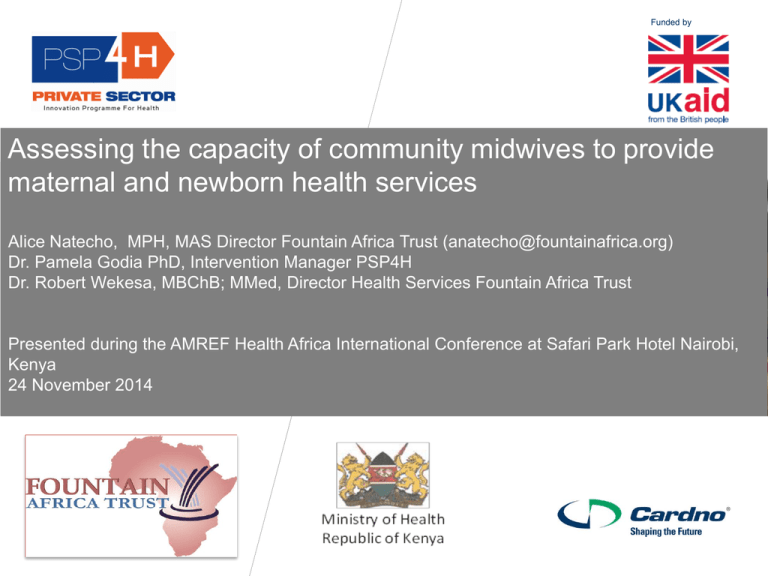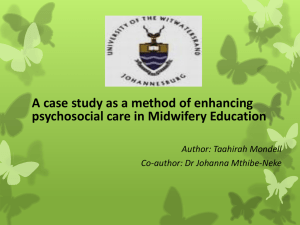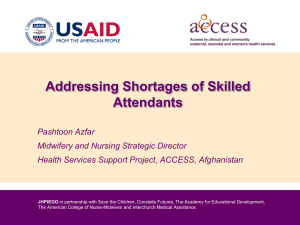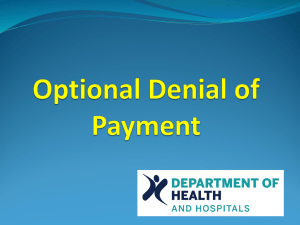
Funded by
Assessing the capacity of community midwives to provide
maternal and newborn health services
Alice Natecho, MPH, MAS Director Fountain Africa Trust (anatecho@fountainafrica.org)
Dr. Pamela Godia PhD, Intervention Manager PSP4H
Dr. Robert Wekesa, MBChB; MMed, Director Health Services Fountain Africa Trust
Presented during the AMREF Health Africa International Conference at Safari Park Hotel Nairobi,
Kenya
24 November 2014
Outline
• Introduction
• Methodology
• Findings
• Conclusion and proposed interventions
Funded by
Introduction-1
•
•
•
•
Funded by
Maternal and infant mortality remains one of the
greatest challenges in Kenya where the maternal
mortality ratio is 488/100,000 live births (KDHS
2008/9).
Over half of pregnant women in Kenya deliver at
home with unskilled assistance
Low use of postnatal care services
Contraceptive Prevalence Rate-low (46%) KDHS
2008/9
Introduction - 2
Funded by
Pop Council, 2013
Introduction-3: Village Midwives Case Studies
Country Evaluation MMR
Period/
Reduction
years
Sir Lanka 1940-1950 1967 - 577
Malaysia 1949-1961 520 - 200
Funded by
Trends in MMRate
Rural –Urban in
Indonesia
Introduction- 4: Justification
• Given the poor MNH indictors, and experiences from the
three countries in Asia, Fountain Africa with PSP4H
chose to strengthen the community midwifery model,
which was launched by government in 2006.
• The model uses community midwifes who provide health
services at community level.
• The current model has had challenges of sustainability –
It heavily relies on supplies from gov’t facilities. See
graph
Funded by
Intro- 5: Erratic supply of Long Acting FP-Methods
CM training update
on LARC provision
(2011)
Population Council &DRH /MOH(2012): Strengthening the Delivery of Comprehensive Reproductive Health Services
through the Community Midwifery Model in Kenya. APHIA II OR Project in Kenya. Population Council: Nairobi, Kenya.
Funded by
Objectives of the study
Overall Objective
To assess the feasibility and effect of
nesting a private sector model within a
community midwifery programme on
maternal and new-born health services
Funded by
Specific Objectives
• Assess the capacity of community midwives to provide
MNH services
• Explore community members perception of the
community midwifery model
• Determine the influence of social networks among
community midwives on increasing access to skilled
maternal health services
• Increase the knowledge and skills of CMs in MNH
services and in entrepreneurship
Funded by
Study Design and Methodology
• A quasi- experimental design
• Sites
• Bungoma County and Butere Mumias Sub
County in Kenya
• Phases
• Baseline
• Intervention
• Evaluation
Funded by
Data Collection
•
•
•
•
•
•
•
Funded by
Quantitative data: 4 structured questionnaires
CMs’ screening tool
CMs’ Knowledge and service provision tool
List of essential equipment and supplies tool
Workload data collection tool (previous 12 months)
Qualitative data:
KII, In-depth interviews, and FGDs
Findings
Demographic information on Community Midwives
72 CMs identified (Bungoma – 43 (59.7%), ButereMumias (Kakamega) – 29 (40.3%)
Sex (Females- 86%, Males-14%)
Mean Age- 61.4 Yrs
Qualification (Enrolled nurse/midwives (85%) and
formerly MoH employees- (88%)
Experience (Average years as CMs -11 yrs
Funded by
MNH Services and average No. of clients seen by CM per month
Bungoma
B-Mumias
CMs
FP
ANC
Delivery
Postnatal care
Treatment of STIs
Immunization
22
12
4
5
6
42
20
8
3
5
6
11
72
72
72
72
72
72
Growth monitoring for babies
Cervical cancer screening
Post rape care
General OP - child
General OP – Adults
Total
24
6
1
36
47
16
13
0.5
24
52
72
72
72
72
72
Funded by
Total
Clients
1,512
720
216
360
432
1,440
1,440
720
72
2,232
3,528
12,672
Cost of CM’s services Median price per visit – Kshs.
Family planning - Long term
Family planning – Short-term
ANC 1st Visit
ANC - Revisit
Delivery
Postnatal care
Treatment of STIs
Immunization
Growth monitoring for babies
Cervical cancer screening
Post rape care
General outpatient - Adults
General outpatient - Children
Funded by
Bungoma
200.00
50.00
50.00
30.00
725.00
50.00
350.00
20.00
0.00
50.00
50.00
300.00
250.00
BM
200.00
50.00
50.00
20.00
650.00
0.00
500.00
20.00
10.00
100.00
100.00
425.00
250.00
Total
200.00
50.00
50.00
25.00
687.00
25.00
425.00
20.00
5.00
75.00
75.00
365.00
250.00
US$
2.3
0.6
0.6
0.3
8.0
0.3
4.9
0.2
0.1
0.9
0.9
4.2
2.9
Client’s ability to pay for services offered by CMs (%)
70.0
58% Cash, 38% both cash & in kind
58.6
60.0
51.4
Percent
50.0
44.2
46.5
43.1
41.4
40.0
30.0
20.0
10.0
4.7
4.7
0.0
0.0
Bungoma
Butere-Mumias
No
Funded by
Yes
N/A
2.8
0.0
Missing
All
2.8
CM willingness to Join a Network
Yes, ….because I will access training,
to help me get the license and get a
better place for delivery-IDI 10, Bgm
Funded by
Reasons cited
•Networking with other CM
•Learning
•Improving supplies
•Financial assistance
•Market their services
Management of CMs finances
Funded by
Provider Knowledge on ANC
Least number of visits women should make during their entire pregnancy
100%
90%
80%
70%
60%
50%
40%
30%
20%
10%
0%
2.3
7.0
0.0
3.6
1.4
5.6
6 Visits
5 Visits
83.7
85.7
84.5
4 Visits
3 Visits
2 Visits
4.7
2.3
Bungoma
7.1
3.6
Butere-Mumias
5.6
2.8
All
Awareness on least no. of ANC visit is high but less than a half know the
timing precisely
Funded by
Providers’ Knowledge on Labour and Delivery
What to Be Done after Delivery (sig. diff. btwn 28.8% P= 0.01;
counties on PPFP, Perineal care, Nutrition)
p=0.03;
Danger Signs of APH (sign. diff btwn BGM & BM) 24.7% P=0.01
Danger Signs Post-Partum Haemorrhage (PPH)
32.6%
Action on retained Placenta (sign. diff btwn 22.5% p< 0.05
Counties)
Action on obstructed Labour (sign. diff btwn
17.7% P<0.05
Counties)
Puerperal Sepsis during Prep (sign. diff btwn
30.% P<0.05
Counties)
Funded by
Knowledge of CMs on Danger signs in Postnatal Period
70
Significant differences between counties - Infection (P=
0.04^BGM) Heavy bleeding (P=0.024^BM)
60
50
40
30
20
10
0
Sepsis/foul Heavy vaginal
Pus oozing
Fever with or
Excessive
Swollen hands,
Severe
Severe lower Don’t know
smelling vaginal
bleeding
from Caesarean without chills tiredness or
face, legs
headache or abdominal pain
discharge/
section scar
breathlessness
blurred vision
Infection
Funded by
Providers’ Knowledge on FP
How the contraceptives work to prevent pregnancy
Butere Bungoma Total
Proportions
P-value
%
58.6
%
72.1
%
66.7
0.234
Thickening the cervical plug/mucus to
prevent sperm penetration
Inhibiting egg transportation
37.9
32.6
34.7
0.639
34.5
23.3
27.8
0.297
Changing the endometrial lining prevent
implantation / thinning of uterine walls
Don’t know
13.8
25.6
20.8
0.227
0.0
14.0
8.3
0.036*
Suppressing or preventing ovulation
Funded by
Perception of the CMs services by the community
•
•
Very essential
Community members (irrespective of their age and
gender) support the work of community midwives
‘It is very essential ….. when it is at night and a
pregnant woman is in labour; not all
pregnancies go to their due dates there are
others which come early so there would be no
preparedness. So if you are within this area
the first people to be contacted are the
domiciliary midwives around…………..
FGD-MEN, COMMUNITY LEADER
Funded by
R4…we normally call them sister, people in the
community are able to differentiate them from
the TBAs
R6….we appreciate them because they assist
us in case of an emergency.
FGD-WOMEN 18-25
Conclusion & Proposed Interventions
• The recent baseline survey demonstrated that:
CMs have great potential in improving access to MNH services
there are many gaps in health service delivery and financial
management that need to be addressed
• Preliminary results already shared with CMs & SHs
• The CMs have already registered a Network
• Planned training activities to focus on the gaps identified
especially in EMoC/LAFP Methods and Business skills
• The County MOH very supportive of the initiative at all levels
Funded by
Acknowledgement
1. Community Midwives in Bungoma County and
Butere Mumias sub County
2. The County Departments of Health in Bungoma
and Kakamega
3. The Private Sector Innovation Programme for
Health
4. Cardno Emerging Markets
5. UKaid
Funded by








